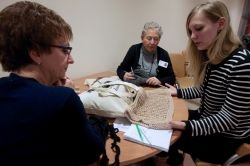Fashion designers harness Dutch grannies’ knitting power

A small room at the back of a retirement home in the suburbs of Rotterdam has been given over to the weekly “knitting club” for women aged 58 to 85, their cheerful chatter almost drowning out the rhythmic click-clacking of knitting needles.
“I think I’ll make this one next,” says an excited Willy Mollenaar, a grandmother in her seventies with dyed light brown hair, pointing to a thick grey woolly hat displayed on a table.
Once she will have copied the design, created by a young Dutch fashion graduate from the Royal Academy of Arts in The Hague, the hat will be sold in a small shop in Rotterdam called “Granny’s Finest”, set up by businessmen Jip Pulles, 31, and Niek van Hengel, 27.
Her only payment will be a photograph of the happy customer wearing the fruits of her labour.
“I was visiting my grandfather in a retirement home and I always saw an old lady knitting,” Van Hengel told AFP, as he served cups of tepid coffee and soft cake to the team of grannies.
“She didn’t have any relatives or friends to knit for but she kept on because it kept her busy and she enjoyed it,” he said.
That “oma”, the Dutch word for grandmother, and the return of knitwear to the catwalk gave him the idea to team up modern designs and traditional techniques, fashion designers with knitting grannies, in a project that combines social inclusion with a commercial spirit.
“My grandchildren don’t like to wear what I knit and I didn’t have anyone to knit for anymore,” said Mollenaar.
“I learned to knit at school and it’s really fun to do, it’s relaxing, but it’s really sad when no one wears or uses what you knit.”
Fellow knitter Loes Wijnbergen, at 58 the youngest of the group, said: “It’s really worthwhile when someone buys and especially wears what we’ve made with our own hands.”
Eager to be resupplied with fresh yarn and new designs to execute, Wijnbergen, Mollenaar and the other women get together every Thursday afternoon, finding new use for a skill passed down through generations.
They look at the designers’ creations, anything from bow ties to bags, before choosing one and starting to knit. But the social side of the club is as important to the elderly women as the knitting patterns.
“I come here just as much for the new designs and for knitting material as for the social contact,” said Niza Rauws, 80.
“It’s not always obvious how to stay busy and meet new people when your old and retired,” she said.
The shop sells a selection of hats, scarves, bracelets and bags ranging in price from 25 to 145 euros (33 to 190 dollars).
The project is partly financed by subsidies from Rotterdam municipality and organisations promoting social cohesion, but it’s not making any money yet.
“It’s a good project for young and old to meet each other,” said the Oranje Fund, which promotes activities to get residents involved in the local community.
The entrepreneurs stress that they’re far from exploiting idle and lonely senior citizens.
“The project’s main aim is social, it’s social cohesion and creative contact between the generations,” said Ven Hengel.
“We make the most of the grannies’ skills while at the same time providing them with a meeting place,” he said.
The fashion designers, often fresh graduates at the start of their careers, see the project as “a way to make a name for yourself while learning the ropes by working with the grannies,” said Annemarije van Harten, 28.
Another designer, Rosanne van der Meer, 33, wants to make a baby knitwear collection for next year’s spring-summer collection.
“I really learn a lot of things from the grannies, about how to make the designs, about which are the right techniques to use,” she said.
“Although, well, sometimes they don’t have the same tastes and aren’t convinced by the designs,” Van der Meer laughs, holding up a pair of baby knitwear dungarees.

